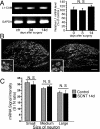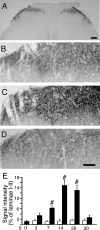Alteration of the cell adhesion molecule L1 expression in a specific subset of primary afferent neurons contributes to neuropathic pain
- PMID: 17331206
- PMCID: PMC1891330
- DOI: 10.1111/j.1460-9568.2007.05344.x
Alteration of the cell adhesion molecule L1 expression in a specific subset of primary afferent neurons contributes to neuropathic pain
Abstract
The cell adhesion molecule L1 (L1-CAM) plays important functional roles in the developing and adult nervous systems. Here we show that peripheral nerve injury induced dynamic post-transcriptional alteration of L1-CAM in the rat dorsal root ganglia (DRGs) and spinal cord. Sciatic nerve transection (SCNT) changed the expression of L1-CAM protein but not L1-CAM mRNA. In DRGs, SCNT induced accumulation of the L1-CAM into the surface of somata, which resulted in the formation of immunoreactive ring structures in a number of unmyelinated C-fiber neurons. These neurons with L1-CAM-immunoreactive ring structures were heavily colocalized with phosphorylated p38 MAPK. Western blot analysis revealed the increase of full-length L1-CAM and decrease of fragments of L1-CAM after SCNT in DRGs. Following SCNT, L1-CAM-immunoreactive profiles in the dorsal horn showed an increase mainly in pre-synaptic areas of laminae I-II with a delayed onset and colocalized with growth-associated protein 43. In contrast to DRGs, SCNT increased the proteolytic 80-kDa fragment of L1-CAM and decreased full-length L1-CAM in the spinal cord. The intrathecal injection of L1-CAM antibody for the extracellular domain of L1-CAM inhibited activation of p38 MAPK and emergence of ring structures of L1-CAM immunoreactivity in injured DRG neurons. Moreover, inhibition of extracellular L1-CAM binding by intrathecal administration of antibody suppressed the mechanical allodynia and thermal hyperalgesia induced by partial SCNT. Collectively, these data suggest that the modification of L1-CAM in nociceptive pathways might be an important pathomechanism of neuropathic pain.
Figures












Similar articles
-
Nociceptive responses and spinal plastic changes of afferent C-fibers in three neuropathic pain models induced by sciatic nerve injury in the rat.Exp Neurol. 2009 May;217(1):84-95. doi: 10.1016/j.expneurol.2009.01.014. Epub 2009 Feb 3. Exp Neurol. 2009. PMID: 19416675
-
Increase of close homolog of cell adhesion molecule L1 in primary afferent by nerve injury and the contribution to neuropathic pain.J Comp Neurol. 2011 Jun 1;519(8):1597-615. doi: 10.1002/cne.22588. J Comp Neurol. 2011. PMID: 21452236
-
Differential galanin upregulation in dorsal root ganglia and spinal cord after graded single ligature nerve constriction of the rat sciatic nerve.J Chem Neuroanat. 2008 Jan;35(1):94-100. doi: 10.1016/j.jchemneu.2007.07.001. Epub 2007 Jul 19. J Chem Neuroanat. 2008. PMID: 17693056
-
L1-CAM and N-CAM: From Adhesion Proteins to Pharmacological Targets.Trends Pharmacol Sci. 2015 Nov;36(11):769-781. doi: 10.1016/j.tips.2015.08.004. Epub 2015 Nov 2. Trends Pharmacol Sci. 2015. PMID: 26478212 Review.
-
Functional Diversity of Neuronal Cell Adhesion and Recognition Molecule L1CAM through Proteolytic Cleavage.Cells. 2022 Sep 30;11(19):3085. doi: 10.3390/cells11193085. Cells. 2022. PMID: 36231047 Free PMC article. Review.
Cited by
-
Macrophage-Colony Stimulating Factor Derived from Injured Primary Afferent Induces Proliferation of Spinal Microglia and Neuropathic Pain in Rats.PLoS One. 2016 Apr 12;11(4):e0153375. doi: 10.1371/journal.pone.0153375. eCollection 2016. PLoS One. 2016. PMID: 27071004 Free PMC article.
-
Functional genomic screen and network analysis reveal novel modifiers of tauopathy dissociated from tau phosphorylation.Hum Mol Genet. 2011 Dec 15;20(24):4947-77. doi: 10.1093/hmg/ddr432. Epub 2011 Sep 23. Hum Mol Genet. 2011. PMID: 21949350 Free PMC article.
-
Persistent changes in spinal cord gene expression after recovery from inflammatory hyperalgesia: a preliminary study on pain memory.BMC Neurosci. 2008 Mar 13;9:32. doi: 10.1186/1471-2202-9-32. BMC Neurosci. 2008. PMID: 18366630 Free PMC article.
-
Aberrant Axo-Axonic Synaptic Reorganization in the Phosphorylated L1-CAM/Calcium Channel Subunit α2δ-1-Containing Central Terminals of Injured c-Fibers in the Spinal Cord of a Neuropathic Pain Model.eNeuro. 2021 Apr 16;8(2):ENEURO.0499-20.2021. doi: 10.1523/ENEURO.0499-20.2021. Print 2021 Mar-Apr. eNeuro. 2021. PMID: 33500315 Free PMC article.
-
Synergistic effects of Buyang Huanwu decoction and embryonic neural stem cell transplantation on the recovery of neurological function in a rat model of spinal cord injury.Exp Ther Med. 2015 Apr;9(4):1141-1148. doi: 10.3892/etm.2015.2248. Epub 2015 Feb 2. Exp Ther Med. 2015. PMID: 25780400 Free PMC article.
References
-
- Aoki E. Localization of nitric oxide-related substances in the peripheral nervous tissues. Brain Res. 1993;620:142–145. - PubMed
-
- Baba H. Silent NMDA receptor-mediated synapses are developmentally regulated in the dorsal horn of the rat spinal cord. JNeurophysiol. 2000;83:955–962. - PubMed
-
- Benowitz LI. GAP-43 as a marker for structural plasticity in the mature CNS. ProgBrain Res. 1990;86:309–320. - PubMed
-
- Brummendorf T. The axonal recognition molecule F11 is a multifunctional protein: specific domains mediate interactions with Ng-CAM and restrictin. Neuron. 1993;10:711–727. - PubMed
Publication types
MeSH terms
Substances
LinkOut - more resources
Full Text Sources
Medical

